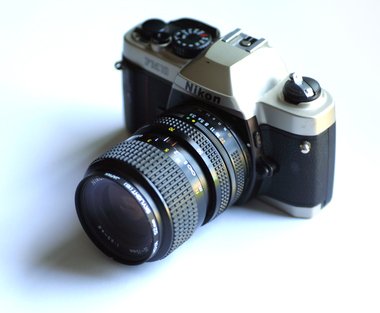I want to tell you a story about two photographers. For a while now, I’ve been wanting to get more into photography, hoping eventually to buy a nice digital SLR camera. So I was quite thrilled when a photojournalist friend offered to give me some of her old film equipment to learn on. The camera, a Nikon FM2, is a fully manual model first introduced almost 30 years ago. It only uses a battery to run the light meter, and the battery on the one she gave me is burnt out — and I’ve been forbidden to replace it. Her thinking is this: if I’m serious about learning how a camera works, I need to hone my skills and instincts so I get a feel for how to put together a good image. A more modern camera (like the later-model auto-focus Nikon she also doesn’t use anymore) wouldn’t teach me that; instead, it would teach me how to use the camera’s bells and whistles. I have another friend who is also a photographer, and I was excited to share with her the news of my new setup. She was more or less unimpressed until I told her what kind of camera it was, then she lit up. “Oh, that’s good — you’ll learn a lot from that!” Then we got to discussing her preference for Nikon cameras, and among other things she said she liked the black-and-white mode in Nikon’s best. “Really?” I asked. “Wouldn’t it be better to convert to black-and-white in Photoshop, where you have far more control over the process?” I might have been asking the Pope about his sex life — the response was rather chilly. Photoshop, to her, was a substitute for skill. Learning to make the best use of what you have in your hands, that’s photography for her, not applying the near-limitless potential of an image program. Both of these photographers were telling me something interesting about not just photography but about… well, about life. They were telling me to stop resisting limits and embrace them as part of the process of creativity. Yes, the Nikon FM2 is a pretty limited camera — that’s what makes it a great learning tool (and, for that matter, it’s what makes it a model that’s remained popular over 3 decades of photographic advance, one that’s still found in many a pro’s toolkit). Yes, in-camera black-and-white is far more limiting than the vast possibilities unleashed by Photoshop — that’s what makes it an art. To embrace those limits and make something beautiful is to accomplish something extraordinary. I can’t help but think of those legendary million monkeys pounding away at a million typewriters. In all that flow of randomness, eventually a string of characters will emerge that tells the story of Hamlet, Prince of Denmark and his stunning descent into madness and eventually death. But it’s the labor of one man, William Shakespeare (or another man posing as Mr. S), scratching away with his goose-feather quill by the dim light of a beeswax candle, groping for the perfect words in the near-dark, that stuns us — one man working with all the limitations of his life and times, all the limitations of the medium and of his mind. That is what elevates a play like Hamlet to the level of art. Aside from a lack of resources — who, after all, has a million monkey laying around and that kind of time to wait? — there are good reasons to oppose unboundedness, to reject a lack of limits. Creativity doesn’t stem from limitlessness. Over and over again, creative people not only challenge limits but seek them out — artists choose a limited palette to paint an image with, musicians strip a complicated arrangement down to voice and acoustic guitar, writers cut and cut and cut again to reach a thousand-word length, and my photographer friend willingly embraces the quirks of her camera’s black-and-white mode over the power of Photoshop. That’s the gift my photojournalist friend gave me: limits. She knew that for under $500 I could pick up a decent used digital SLR setup. But on a digital camera, it would be easy to just learn how to harness the power of the camera — to let it do my focusing, metering, white balancing, and everything else for me. I might learn good composition, but I wouldn’t learn photography. The education of an artist or craftsperson consists mainly in learning about limits; I would argue that their creative spark comes from embracing those limits. That’s good advice for the rest of us, who spend quite a bit of time bemoaning the limitations forced on us by our circumstances without even trying to understand them. My advice — or rather, my friends’ advice — is this: understand your limits, embrace them, and use them. It’s what they’re there for.
